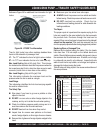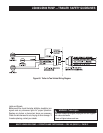
PAGE 58 — MAYCO LS400/LS500 PUMP — OPERATION AND PARTS MANUAL — REV. #6 (09/19/11)
LS400/LS500 PUMP — TRAILER SAFETY GUIDELINES
U.S. DOT Tire Identification Number: This begins with
the letters “DOT” and indicates that the tire meets all federal
standards. The next two numbers or letters are the plant
code where it was manufactured, and the last four numbers
represent the week and year the tire was built. For example,
the numbers 3197 means the 31st week of 1997. The other
numbers are marketing codes used at the manufacturer’s
discretion. This information is used to contact consumers
if a tire defect requires a recall.
Tire Ply Composition and Materials Used: The number
of plies indicates the number of layers of rubber-coated fabric in
the tire. In general, the greater the number of plies, the more
weight a tire can support. Tire manufacturers also must indi-
cate the materials in the tire, which include steel, nylon, poly-
ester, and others.
Maximum Load Rating: This number indicates the maxi-
mum load in kilograms and pounds that can be carried by
the tire.
Maximum Permissible Inflation Pressure: This number
is the greatest amount of air pressure that should ever be
put in the tire under normal driving conditions.
Uniform Tire Quality Grading Standards (UTQGS)
Treadwear Number: This number indicates the tire’s wear
rate. The higher the treadwear number is, the longer it should
take for the tread to wear down. For example, a tire graded
400 should last twice as long as a tire graded 200.
Traction Letter: This letter indicates a tire’s ability to stop
on wet pavement. A higher graded tire should allow you to
stop your car on wet roads in a shorter distance than a tire
with a lower grade. Traction is graded from highest to lowest
as “AA”,”A”, “B”, and “C”.
Temperature Letter: This letter indicates a tire’s resistance
to heat. The temperature grade is for a tire that is inflated
properly and not overloaded. Excessive speed, underinflation
or excessive loading, either separately or in combination,
can cause heat build-up and possible tire failure. From high-
est to lowest, a tire’s resistance to heat is graded as “A”,
“B”, or “C”.
P: The “P” indicates the tire is for passenger vehicles.
Next number: This three-digit number gives the width in
millimeters of the tire from sidewall edge to sidewall edge. In
general, the larger the number, the wider the tire.
Next number: This two-digit number, known as the aspect
ratio, gives the tire’s ratio of height to width. Numbers of 70
or lower indicate a short sidewall for improved steering
response and better overall handling on dry pavement.
P: The “R” stands for radial. Radial ply construction of tires
has been the industry standard for the past 20 years.
Next number: This two-digit number is the wheel or rim
diameter in inches. If you change your wheel size, you will
have to purchase new tires to match the new wheel
diameter.
Next number: This two- or three-digit number is the tire’s
load index. It is a measurement of how much weight each
tire can support. You may find this information in your owner’s
manual. If not, contact a local tire dealer. Note: You may not
find this information on all tires because it is not required by
law.
M+S: The “M+S” or “M/S” indicates that the tire
has some mud and snow capability. Most radial tires have
these markings; hence, they have some mud and snow ca-
pability.
Speed Rating: The speed rating denotes the speed at which
a tire is designed to be driven for extended periods of time.
The ratings range from 99 miles per hour (mph) to 186 mph.
These ratings are listed in Table 7. Note: You may not find
this information on all tires because it is not required by law.
gnitaRdeepS.6elbaT
gnitaRretteLgnitaRdeepS
Qhpm99
Rhpm601
Shpm211
Thpm811
Uhpm421
Hhpm031
Vhpm941
Whpm*861
Yhpm*681


















